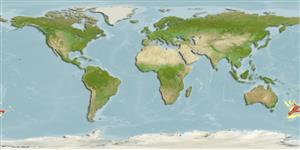Environment: milieu / climate zone / depth range / distribution range
Ecología
marino batidemersal; rango de profundidad 5 - 1153 m (Ref. 26346). Deep-water
Distribución
Países | Áreas FAO | Ecosistemas | Ocurrencias, apariciones | Point map | Introducciones | Faunafri
Southwest Pacific: endemic to New Zealand. Specimens recently seen at Norfolk Island may be this species. Torpedo macneilli from Australia is very similar to this species (Ref. 6871).
Tamaño / Peso / Age
Maturity: Lm ? range ? - ? cm
Max length : 100.0 cm TL macho / no sexado; (Ref. 26346)
Short description
Morfología | Morfometría
Dark grey dorsally, white ventrally (Ref. 26346).
Found on the continental shelf and upper slope (Ref. 26346). Feeds on fish, probably at night (Ref. 26346). Ovoviviparous (Ref. 50449).
Life cycle and mating behavior
Madurez | Reproducción | Puesta | Huevos | Fecundidad | Larva
Exhibit ovoviparity (aplacental viviparity), with embryos feeding initially on yolk, then receiving additional nourishment from the mother by indirect absorption of uterine fluid enriched with mucus, fat or protein through specialised structures (Ref. 50449).
Cox, G. and M. Francis, 1997. Sharks and rays of New Zealand. Canterbury Univ. Press, Univ. of Canterbury. 68 p. (Ref. 26346)
IUCN Red List Status (Ref. 130435)
Human uses
Más información
Age/SizeCrecimientoLength-weightLength-lengthLength-frequenciesMorfometríaMorfologíaLarvaDinámica larvariaReclutamientoAbundanciaBRUVS
ReferenciasAcuiculturaPerfil de acuiculturaRazasGenéticaElectrophoresesheritabilidadEnfermedadesProcesamientoNutrientsMass conversion
ColaboradoresImágenesStamps, Coins Misc.SonidosCiguateraVelocidadTipo de nataciónSuperficie branquialOtolitosCerebrosVisión
Herramientas
Special reports
Download XML
Fuentes de Internet
Estimates based on models
Preferred temperature (Ref.
123201): 9.5 - 14.1, mean 12 °C (based on 33 cells).
Phylogenetic diversity index (Ref.
82804): PD
50 = 0.5001 [Uniqueness, from 0.5 = low to 2.0 = high].
Bayesian length-weight: a=0.01479 (0.00659 - 0.03318), b=2.97 (2.78 - 3.16), in cm total length, based on LWR estimates for this (Sub)family-body shape (Ref.
93245).
Nivel trófico (Ref.
69278): 4.5 ±0.80 se; based on food items.
Resiliencia (Ref.
120179): Muy bajo, población duplicada en un tiempo mínimo superior a 14 años (Preliminary K or Fecundity.).
Fishing Vulnerability (Ref.
59153): High vulnerability (60 of 100).
